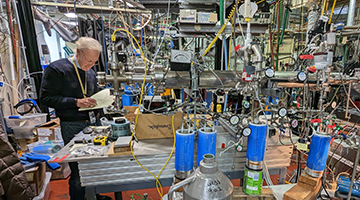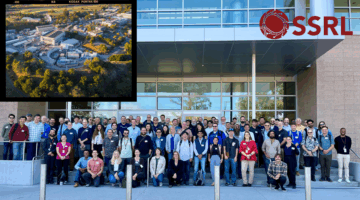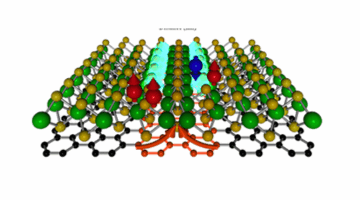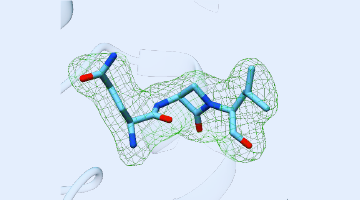Using ALS beamlines, a new study revealed how CMX410 inhibits Pks13, a cell wall enzyme in Mycobacterium tuberculosis, the bacterium responsible for tuberculosis. CMX410 is effective against drug-sensitive and drug-resistant strains of the bacterium and has been proven safe in multiple animal models of infection. Read more »![]()
![]()
The Advanced Light Source is a U.S. Department of Energy scientific user facility at Lawrence Berkeley National Laboratory. Our mission is to advance science for the benefit of society by providing our world-class synchrotron light source capabilities and expertise to a broad scientific community.

UEC Nominations Due October 31, 2025
The Advanced Light Source Users’ Executive Committee (UEC) invites nominations for its upcoming election for five new UEC members (2026–2028 term). Nominations will be accepted through Friday, October 31, 2025. Take a look at what is involved, and remember that self-nominations are welcome! Read more »

Like the Sun, ALS Fractures Nitrogen Gas to Study Alien Atmospheres
A research team used the ALS to recreate how the Sun breaks apart nitrogen to inform a new model that can be used to understand the fate of a variety of elemental isotopes to explain atmospheric evolution on planets across the solar system. Read more »

Beam Across the Bay: ALS Visits SSRL
It is rare to find synchrotron light sources around the world, much less two within 50 miles of each other. Capitalizing on their proximity, the Stanford Synchrotron Radiation Lightsource hosted the Advanced Light Source for a day of introductions and reconnections, all in the name of science. Read more »

Separating an Electron into Waves of Spin and Charge
Researchers are exploring how a thin film can host a Tomonaga–Luttinger liquid, which separates an electron’s charge and spin. The research findings could contribute to the development of ultra-compact and energy-efficient technologies. Read more »
Recent High-Impact Publications
- Hlevyack, J.A., S.-Y. Guan, Y.-C. Tsui, C.-A. Wang, W.-Y. Chen, M.-K. Lin, Y. Li, S.S. Babu, P. Chen, R.-Y. Liu, J. Lee, J. Hwang, S. Tang, Y. Bai, D. Flötotto, S.-K. Mo, J.N. Eckstein, P. Abbamonte, T.-M. Chuang, and T.C. Chiang, “Topological Surface Superconductivity via Josephson Coupling in Bi2Te3/Nb,” Nano Letters 25, 16387?16394 (2025), doi:10.1021/acs.nanolett.5c04230 (November 8, 2025).
- Oh, D., A. Hampel, J.P. Wakefield, P.C. Moen, S. Smit, X. Luo, M. Zonno, S. Gorovikov, M. Leandersson, C. Polley, A.K. Kundu, A. Rajapitamahuni, E. Vescovo, C. Jozwiak, A. Bostwick, E. Rotenberg, M. Isobe, M. Verma, M. Crispino, M. Grundner, F.B. Kugler, O. Parcollet, U. Schollwöck, H. Takagi, A. Damascelli, G. Sangiovanni, J.G. Checkelsky, A. Georges, and R. Comin, “Hund's flat band in a frustrated spinel oxide,” Proceedings of the National Academy of Sciences of the United States of America 122, e2518213122 (2025), doi:10.1073/pnas.2518213122 (November 6, 2025).
- Min, C., S. Müller, W.J. Choi, L.E. Dudy, V. Zabolotnyy, M. Heber, J.D. Denlinger, C.-J. Kang, M. Kallaene, N.O. Wind, M.D. Scholz, T.L. Lee, C. Schlueter, A. Gloskovskii, E.L. Rienks, V. Hinkov, H. Bentmann, Y.S. Kwon, F.T. Reinert, H.-D. Kim, and K. Rossnagel, “Polaronic Quasiparticles in the Valence-Transition Compound TmSe1-xTex,” Physical Review Letters 135, 186501 (2025), doi:10.1103/72dv-ynm2 (October 29, 2025).
- Etxebarria, A., P. Aydogan Gokturk, Y. Ye, P.N. Ross, E. Crumlin, and M.Á. Muñoz-Márquez, “Probing the Surface Chemistry of Lithium Nitridation,” Journal of the American Chemical Society 147, 40398 (2025), doi:10.1021/jacs.5c11781 (October 26, 2025).
- Su, H., J. Chai, Z. Guan, H. Bluhm, Z. Zhang, Y. Cao, Z. Liu, Y.-H. Lin, W.C. Chueh, L. Zhang, and D. Chen, “Tuning the f Band for Enhanced Surface Redox in Strained Rare Earth Oxides,” Journal of the American Chemical Society 147, 40196 (2025), doi:10.1021/jacs.5c08872 (October 24, 2025).
